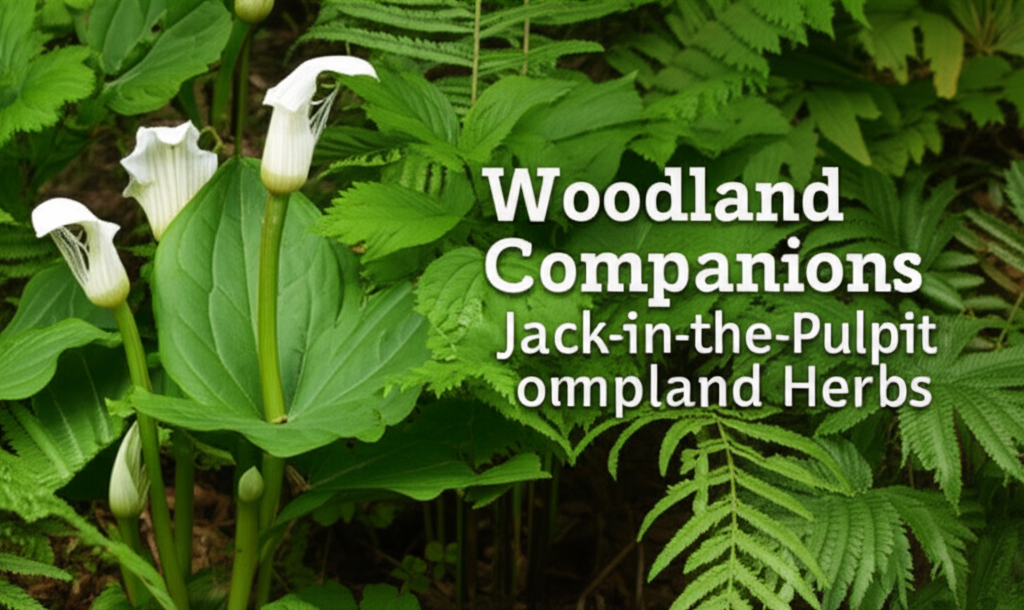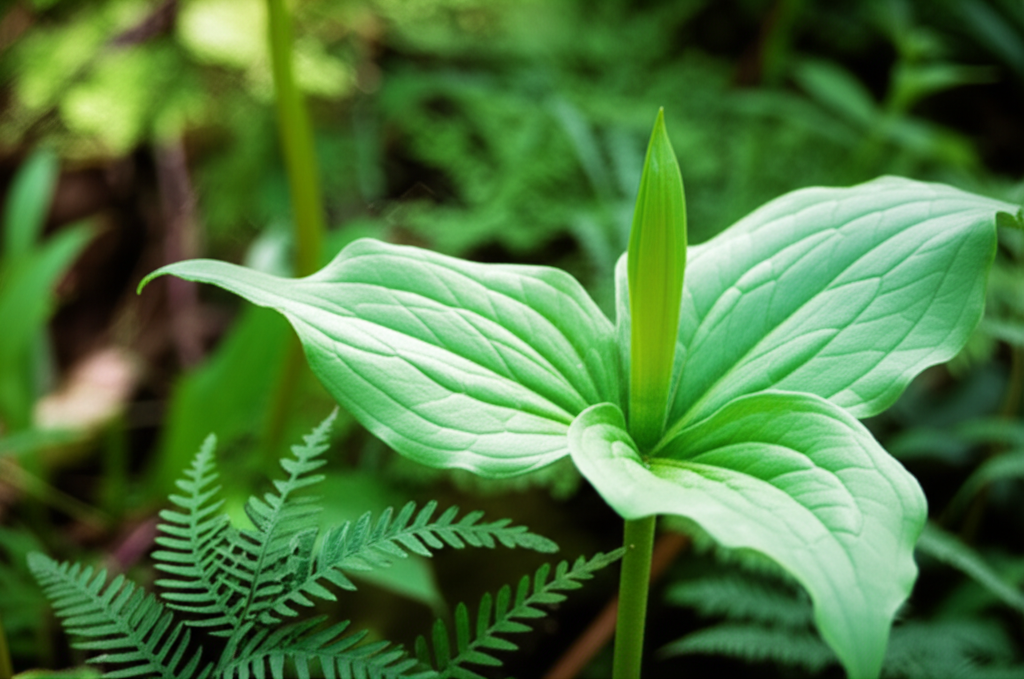Introduction: The Allure of the Jack-in-the-Pulpit
The Jack-in-the-Pulpit (Arisaema triphyllum) is a truly captivating native wildflower, instantly recognizable by its unique spathe and spadix structure that resembles a preacher in a pulpit. Thriving in the dappled shade of woodlands, its presence signifies a healthy, vibrant ecosystem. Beyond its aesthetic appeal, this fascinating plant offers intriguing possibilities for companion planting, allowing gardeners to create self-sustaining, ecologically rich woodland gardens. Companion planting, the practice of growing different plants together for mutual benefit, can enhance growth, deter pests, attract beneficial insects, and improve soil health. This article delves into the world of Jack-in-the-Pulpit companion planting, exploring the ideal partners that will help your woodland garden flourish.
Understanding Jack-in-the-Pulpit’s Needs

Before we explore its companions, it’s crucial to understand what the Jack-in-the-Pulpit requires to thrive. These woodland natives prefer:
- Shade: Dappled shade to partial shade is ideal. Deep shade can hinder flowering and growth, while full sun will scorch its leaves.
- Moist, Well-Drained Soil: They appreciate consistently moist soil, but not waterlogged conditions. Rich, loamy soil with plenty of organic matter is preferred.
- Slightly Acidic to Neutral pH: A pH between 5.5 and 7.0 is generally suitable.
- Protection from Strong Winds: Their delicate foliage can be easily damaged by harsh winds.
By understanding these fundamental needs, we can select companion plants that not only tolerate similar conditions but also contribute positively to the microclimate.
Key Companion Planting Principles for Woodland Gardens
When designing a woodland garden, several companion planting principles come into play:
1. Mimicking the Natural Ecosystem
The most successful woodland gardens replicate the layered structure and plant communities found in natural forests. This involves understanding the different strata: canopy trees, understory shrubs, herbaceous layers, and groundcovers. Jack-in-the-Pulpits typically reside in the herbaceous layer.
2. Nutrient Cycling and Soil Improvement
Companion plants can contribute to nutrient cycling by fixing nitrogen, adding organic matter through decomposition, or drawing up nutrients from deeper soil layers.
3. Pest and Disease Management
Certain plants can deter pests or attract beneficial insects that prey on common garden pests. This reduces the need for chemical interventions.
4. Water Management
Some companions can help retain soil moisture, while others with deeper root systems can improve drainage.
5. Visual Harmony and Biodiversity
Beyond ecological benefits, companion planting can create aesthetically pleasing arrangements and increase overall biodiversity, making your garden a haven for wildlife.
Ideal Woodland Herb Companions for Jack-in-the-Pulpit
Several woodland herbs are excellent companions for Jack-in-the-Pulpit, sharing similar habitat preferences and offering mutualistic benefits.
1. Wild Ginger (Asarum canadense)
Wild ginger is a fantastic groundcover that thrives in the same shady, moist conditions as Jack-in-the-Pulpit. Its kidney-shaped leaves create a lush carpet, suppressing weeds and retaining soil moisture. Wild ginger also has a symbiotic relationship with certain ants that help disperse its seeds.
- Benefits:
Excellent groundcover, suppressing weeds.
Retains soil moisture.
Aesthetically pleasing foliage.
Attracts specific pollinators.
2. Mayapple (Podophyllum peltatum)
Mayapple forms colonies in shady, moist woodlands. Its umbrella-like leaves create a distinctive woodland feel. While it can spread, it does so at a manageable pace and often benefits from being paired with plants that can tolerate its slightly allelopathic tendencies (releasing chemicals that can inhibit the growth of some plants).
- Benefits:
Unique architectural foliage.
Can help suppress competing weeds.
Provides shade for the soil, retaining moisture.
3. Foamflower (Tiarella cordifolia)
Foamflower is a delightful woodland perennial known for its delicate, foamy white flower spikes in spring and attractive, often lobed foliage that can persist through winter. It prefers shady, moist, and humus-rich soil, making it a perfect neighbor for Jack-in-the-Pulpit.
- Benefits:
Beautiful spring blooms.
Attractive evergreen or semi-evergreen foliage.
Excellent at stabilizing soil on slopes.
Attracts native bees and other pollinators.
4. Bluebells (Mertensia virginica)
Virginia bluebells are ephemeral wildflowers that add a splash of vibrant blue to the woodland floor in spring. They go dormant in the summer, leaving space for other plants to thrive. Their blooming period often coincides with the emergence of Jack-in-the-Pulpit, creating a stunning visual display.
- Benefits:
Spectacular spring floral display.
Goes dormant, allowing other plants to fill the space.
Attracts early pollinators.
5. Columbine (Aquilegia canadensis)
Wild columbine is a charming native with distinctive red and yellow spurred flowers that attract hummingbirds. It prefers well-drained, but moist soil and can tolerate partial shade. Its nodding flowers add a different texture and color to the woodland understory.
- Benefits:
Attracts hummingbirds and other pollinators.
Adds architectural interest with its unique flowers.
Tolerates a range of light conditions.
Fascinating Fern Companions for Jack-in-the-Pulpit
Ferns are quintessential woodland plants, and many species are excellent companions for Jack-in-the-Pulpit, enhancing the naturalistic feel and contributing to a moist, shady environment.
1. Ostrich Fern (Matteuccia struthiopteris)
Ostrich ferns are large, vase-shaped ferns that thrive in moist to wet soil and partial shade. Their upright fronds create a dramatic effect, and they spread via rhizomes, forming dense colonies that can help suppress weeds and retain moisture.
- Benefits:
Creates a lush, woodland aesthetic.
Excellent at holding soil moisture.
Suppresses competing vegetation.
Provides habitat for small woodland creatures.
2. Christmas Fern (Polystichum acrostichoides)
Christmas ferns are evergreen, providing year-round greenery in the woodland garden. They are adaptable and can tolerate a range of conditions, including dry shade once established, though they perform best in moist, well-drained soil. Their leathery fronds add a different texture.
- Benefits:
Provides evergreen interest.
Adaptable to various light conditions.
Adds textural contrast.
Can tolerate some dryness once established.
3. Lady Fern (Athyrium filix-femina)
Lady ferns are delicate and airy, with lacy fronds that add a soft elegance to the woodland floor. They prefer moist, shady conditions and can form attractive clumps.
- Benefits:
Graceful, delicate foliage.
Prefers moist, shady environments.
Adds a lighter texture to the planting.
4. Spinulose Wood Fern (Dryopteris carthusiana)
This fern is adaptable and can tolerate a wider range of light conditions than some other ferns, including drier soils once established, though it still prefers moisture. Its finely divided fronds create a full, lush appearance.
- Benefits:
Adaptable to various light and moisture levels.
Provides dense, green foliage.
Contributes to soil stabilization.
| Plant Type | Common Name | Scientific Name | Preferred Conditions | Key Benefits |
|---|---|---|---|---|
| Woodland Herbs | Wild Ginger | Asarum canadense | Shade, moist soil, humus-rich | Groundcover, weed suppression, moisture retention |
| Mayapple | Podophyllum peltatum | Shade, moist soil | Weed suppression, moisture retention, unique foliage | |
| Foamflower | Tiarella cordifolia | Shade, moist soil, humus-rich | Spring blooms, attractive foliage, soil stabilization | |
| Bluebells | Mertensia virginica | Shade, moist soil | Spring blooms, early pollinators, dormancy allows for other plants | |
| Columbine | Aquilegia canadensis | Partial shade, moist, well-drained soil | Attracts hummingbirds, unique flowers, architectural interest | |
| Ferns | Ostrich Fern | Matteuccia struthiopteris | Moist to wet soil, partial shade | Lush aesthetic, moisture retention, weed suppression |
| Christmas Fern | Polystichum acrostichoides | Partial shade, moist, well-drained soil (adaptable) | Evergreen, textural contrast, soil stabilization | |
| Lady Fern | Athyrium filix-femina | Moist soil, shade | Delicate foliage, soft texture, habitat creation | |
| Spinulose Wood Fern | Dryopteris carthusiana | Moist soil, partial shade (adaptable) | Dense foliage, soil stabilization, adaptability |
Other Beneficial Woodland Companions
Beyond herbs and ferns, a few other native plants can further enhance a Jack-in-the-Pulpit garden.
1. Trillium (Trillium spp.)
Many Trillium species are native to woodlands and share the same environmental preferences. Their elegant, single blooms in spring are a welcome sight, and their presence indicates a healthy woodland ecosystem.
- Benefits:
Iconic woodland wildflower.
Adds delicate beauty to the spring garden.
Indicator of healthy woodland soil.
2. Bloodroot (Sanguinaria canadensis)
Bloodroot is another early spring ephemeral with a single, delicate white flower and a distinctive grey-green, lobed leaf. It thrives in shady, moist conditions and goes dormant by summer, similar to bluebells.
- Benefits:
Early spring bloom.
Unique foliage.
* Goes dormant, leaving space for other plants.
Considerations for Planting and Design
When planting Jack-in-the-Pulpit and its companions, consider the following:
1. Spacing and Growth Habits
Allow adequate space for each plant to reach its mature size. Jack-in-the-Pulpit itself can form clumps, and companions like Ostrich Ferns and Wild Ginger can spread. Plan for this growth to avoid overcrowding.
2. Soil Preparation
Amend the soil with plenty of organic matter, such as compost or well-rotted leaf mold, to mimic the rich, loamy soil of a natural woodland. Ensure good drainage, especially for plants like Columbine.
3. Layering and Height
Consider planting taller companions like Ostrich Ferns towards the back of the planting, with Jack-in-the-Pulpit and smaller ferns or flowers in the middle and foreground. This creates visual depth and interest.
4. Seasonal Interest
Choose a mix of plants that offer interest throughout the growing season. Ephemerals like Bluebells and Bloodroot provide early spring color, while evergreen ferns and Trilliums offer structure.
5. Water Requirements
While most companions prefer moist conditions, ensure they are not waterlogged. Group plants with similar watering needs together.
The Pros and Cons of Jack-in-the-Pulpit Companion Planting
Implementing companion planting for Jack-in-the-Pulpit offers numerous advantages, but it’s also important to be aware of potential challenges.
| Category | Pros | Cons |
|---|---|---|
| Ecological Benefits |
|
|
| Gardening Benefits |
|
|
| Plant Health |
|
|
Conclusion: Cultivating a Vibrant Woodland Sanctuary
The Jack-in-the-Pulpit is more than just a unique wildflower; it’s an anchor plant for creating a thriving, self-sustaining woodland garden. By thoughtfully selecting companion plants like Wild Ginger, Ostrich Ferns, Foamflower, and Bluebells, you can foster an environment where these plants not only survive but flourish together. This approach not only beautifies your garden but also supports local ecosystems, providing habitat and food for a variety of wildlife. Embrace the principles of companion planting and watch as your woodland oasis comes alive with beauty, biodiversity, and ecological harmony. Remember to observe your plants, adjust as needed, and enjoy the process of cultivating your own piece of the wild.


